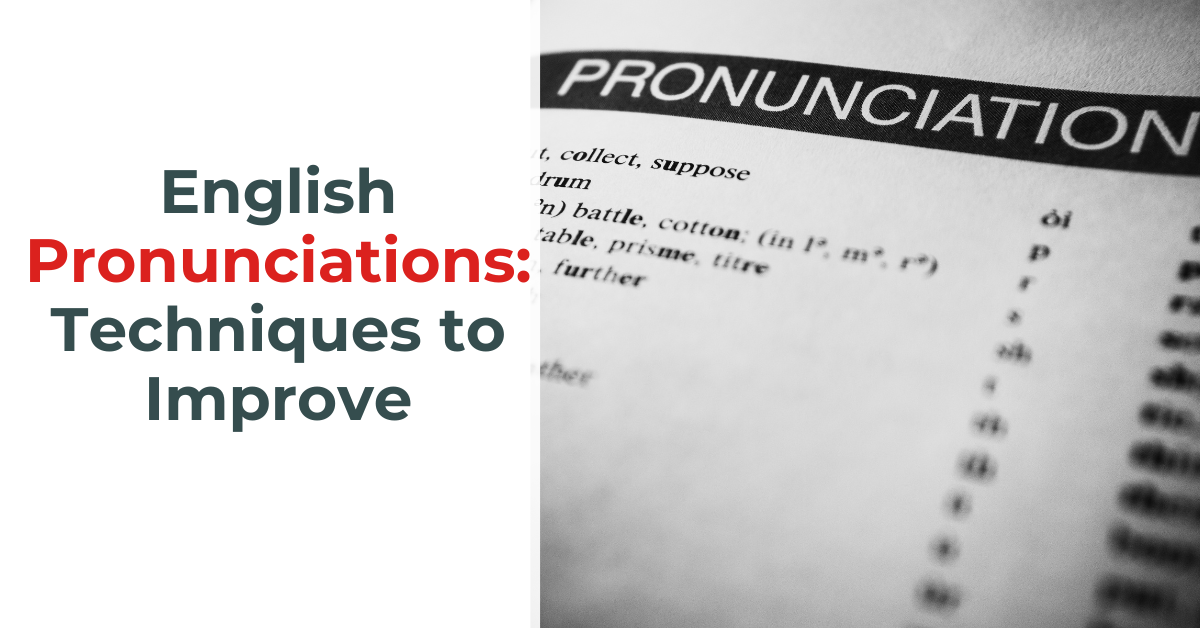Mastering English pronunciation can be a challenging task for non-native speakers. Pronunciation plays a crucial role in effective communication and can greatly enhance your overall language proficiency. In this blog, we will explore advanced techniques to improve English pronunciation, providing you with tips and tricks to refine your skills and sound more like a native speaker. By incorporating these techniques into your language learning journey, you can boost your confidence and clarity in spoken English.
1. Mimic Native Speakers:
One effective technique to improve English pronunciation is to mimic native speakers. Listen closely to native speakers, whether through podcasts, movies, or conversations, and pay attention to their intonation, rhythm, and stress patterns. Try to imitate their pronunciation and cadence, focusing on individual sounds and word stress. By actively engaging in mimicry, you train your ears and muscles to produce English sounds more accurately.
Example: Let’s consider the pronunciation of the word “pronunciation.” Pay attention to the stress on the second syllable: pro-NUN-ci-a-tion. Listen to how native speakers emphasize this syllable, and practice saying it with the same stress and intonation.
2. Record and Listen to Yourself:
Recording your own voice and listening to it can be a valuable tool for self-assessment and improvement. Choose a passage or a dialogue in English, read it aloud, and record your voice. Then, compare your pronunciation with that of native speakers. Take note of any differences in sounds, stress, or intonation. Identify areas where you need improvement and make conscious efforts to correct them.
Example: Practice recording yourself reading a paragraph from an English book or an article. Pay attention to individual sounds, stress patterns, and clarity of your pronunciation. Compare it with a native speaker’s rendition of the same passage and make adjustments accordingly.
3. Focus on Problematic Sounds:
Every language has its own set of sounds that may be challenging for non-native speakers. Identify the sounds in English that have difficult pronunciation and concentrate on improving them. For instance, many non-native English speakers struggle with vowel sounds, such as “th” (as in “the” and “this”) and “r” sounds. Practice these sounds repeatedly, both in isolation and within words, until you can produce them accurately.
Example: The “th” sound can be particularly challenging for some non-native English speakers. Practice saying words like “the,” “that,” and “this” to work on correctly forming the “th” sound. Focus on placing your tongue gently between your teeth and exhaling softly.
4. Pay Attention to Word Stress and Intonation:
English has a strong emphasis on word stress, where certain syllables within words are pronounced more prominently than others. Understanding and using correct word stress patterns can significantly improve your English pronunciation. Additionally, pay attention to intonation patterns, which involve the rise and fall of pitch in your speech. Proper intonation helps convey meaning and emotions effectively.
Example: Consider the word “present” (noun) and “present” (verb). In the noun form, the stress is on the first syllable, while in the verb form, the stress is on the second syllable. Practice saying both forms, emphasizing the correct syllable to convey the intended meaning.
5. Utilize Online Study Resources:
Leverage the power of technology by using online resources and pronunciation apps specifically designed to improve English pronunciation. Websites like Forvo and YouGlish provide audio pronunciations of words and phrases by native speakers. Pronunciation apps like ELSA Speak and Speechling offer interactive exercises and feedback to help you refine your pronunciation skills.
Example: Utilize apps like ELSA Speak or Speechling to practice specific sounds, receive instant feedback, and engage in meaningful pronunciation exercises. These apps often utilize speech recognition technology to analyze your pronunciation accuracy and provide targeted feedback, allowing you to track your progress over time.
6. Engage in Conversations and Seek Feedback:
Practicing English pronunciation in real-life conversations is crucial for improvement. Engage in conversations with native speakers or language exchange partners to gain exposure to different accents and speaking styles. Be open to receiving feedback on your pronunciation and ask for specific areas where you can improve. Native speakers can provide valuable insights and guidance to refine your pronunciation skills further.
Example: Join language exchange groups, conversation clubs, or online forums where you can interact with native English speakers. Engage in conversations and actively seek feedback on your pronunciation. This real-time practice will help you identify areas for improvement and make necessary adjustments.
7. Slow Down and Focus on Clarity:
When speaking English, it is essential to maintain a moderate pace and prioritize clarity over speed. Many pronunciation errors occur when non-native speakers rush through words and sentences. Slow down your speech, enunciate each sound clearly, and give proper attention to word endings and consonant clusters. This deliberate and mindful approach will improve your pronunciation accuracy.
Example: Instead of rushing through a sentence like “I went to the store yesterday,” consciously pronounce each word clearly and ensure that all sounds are articulated correctly. Focus on proper word endings and the clarity of consonant sounds.
8. Practice Tongue Twisters and Minimal Pairs:
Tongue twisters and minimal pairs are excellent exercises for improving english pronunciation accuracy. Tongue twisters, such as “She sells seashells by the seashore,” challenge your articulation skills and help you master difficult sounds and combinations. Minimal pairs, such as “ship” and “sheep” or “bought” and “brought,” highlight the subtle differences between similar-sounding words, allowing you to distinguish and produce them correctly.
Example: Practice tongue twisters like “Peter Piper picked a peck of pickled peppers” or minimal pairs like “light” and “right.” Repeat them multiple times, focusing on the accuracy of each sound, and gradually increase the speed as you become more comfortable.
Conclusion:
Improving English pronunciation requires dedication, practice, and exposure to native speakers. By implementing advanced techniques such as mimicking native speakers, recording and self-assessment, focusing on problematic sounds, mastering word stress and intonation, utilizing online resources and apps, engaging in conversations, and practicing with tongue twisters and minimal pairs, you can refine your pronunciation skills and sound more like a native English speaker. Embrace the journey of learning and enjoy the progress you make in your English pronunciation, knowing that clear and effective communication awaits you.
Also Read: Tips to Avoid Common Grammar Mistakes




